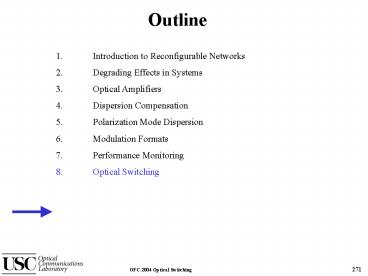Outline - PowerPoint PPT Presentation
1 / 20
Title: Outline
1
Outline
1. Introduction to Reconfigurable
Networks 2. Degrading Effects in
Systems 3. Optical Amplifiers 4. Dispersion
Compensation 5. Polarization Mode
Dispersion 6. Modulation Formats 7. Performance
Monitoring 8. Optical Switching
2
Optical Switching
2.5 Gb/s
SONET
NRZ
622 Mb/sec
ATM RZ
All-Optical Network
10 Gb/s IP
Transparency
3
Circuit Switching vs. Packet Switching
Easy to implement and control
11000011
Relatively large overhead
00100101
0110001
Good for low-speed
0110111
transmission and long transfer times
Packet
More strict switching requirements
A2
A1
C1
A1
Relatively low fixed overhead
C1
A2
A2
A1
C1
C1
A2
A1
C1
Higher efficiency for bursty traffic
Requires contention resolution and signaling
4
Optical Circuit vs. Packet Switching
Circuit Switching
Packet Switching
- ADVANTAGES
- msec switching
- Quality of Service
- Network restoration
- ADVANTAGES
- High efficiency
- Survivability
- Statistical multiplexing
Transition with MPxS
- CHALLENGES
- Scalability, reconfigurability
- Fiber dispersion, nonlinearity
- EDFA gain equalization
- Monitoring and management
- CHALLENGES
- Optical buffering
- Header processing
- Fast switching (msec or nsec)
- Bit and packet synchronization
- Bit rate transparency
5
Passive Tapping of an Optical Packet
ON/OFF
Switch
Output
Incoming
Port A
Signal
Splitter
Passive
Output
Optical
ON/OFF
Port B
Tap
Switch
Optical
Detector
Control
Signal
6
Optical Router Functions
WDM input
WDM output
address/label updating (label swapping)
contention resolution
regeneration
optical switch matrix
demux
timing
monitoring
contention detection switching control unit
packet arrival detection
address/label recognition
routing decision
optical look-up table for switching decision
O/E conversion electronic processing FULL look-up
table
7
Electrical vs. Optical switching
Disadvantages of electrical switch
Disadvantages of optical switch
- Not scalable
- Usually blocking
- High power/space consumption
- Opaque Requires operation
- at the bit rate/format
- Costly operations/upgrades
- High power/space
- consumption
- Costly operations/upgrades
- No bit level intelligence
Advantages of optical switch
Advantages of electrical switch
- Non-blocking
- Transparent Operation at any bit rate/format
- Wavelength continuity
- along the path
- Bit level intelligence
- Mature technology
- Low cost to manufacture
8
Signal Degradation in an Optical Switch
- Analog transmission issues
- Input signal power (dynamic range)
- Output signal-to-noise ratio (O-SNR)
- Dispersion and chirp
- Nonlinear effects
- Crosstalk
- Polarization dependence
- Wavelength dependence
9
Optical 3R
WDM input
Re-timing nonlinear optical element
Re-amp smart equalizing amplifier
Re-shaping dynamic CD/PMD compensation
Optical signal quality monitoring
Electronic processing
network node
10
3R in optical switching
1
Input
0
t
Noise
and SNR
Figure
Degrading effects
Regeneration
- Amplifier noise accumulation
- Dispersion of the link
- Extinction ratio
- SNR
- Timing jitter of the clock
- Filtering out the noise
- Re-shaping the signal
- Dispersion compensation
- Re-timing of the signal using
- an optical nonlinear gate
B. Sartorius, ICTON 2001
11
(No Transcript)
12
Contention Resolution in an Optical Switch
Assuming all packets are destined to output port
C Ppacket
Packet loss
Deflection routing
Packet P1 is routed, packet P2 is dropped, and
the data is lost
Packet P2 is misrouted to D, may take longer to
reach destination
Optically buffered
Wavelength conversion
OXC
A
C
B
D
Packet P2 is buffered and routed when port C is
available
Packet P2 is ?-shifted, both P1 and P2 are routed
to port C
13
The Benefits of Optical Buffering
The use of optical buffers in switched
all-optical networks
Length 30, packetloss 10-8
log10 packet loss ratio
Buffer length (in packets)
Without the use of optical buffers, the packet
loss rate in a 4x4 optical switch with an 80
load can exceed 10. When a single
sequential-access optical buffer with a length of
30 packets is added, the packet loss rate drops
to 10-8.
Hunter, JLT, Dec 1998
14
Types of Wavelength Conversion
Optoelectronic-
O/E/O
All-optical
Incoherent Interactions
Cross-gain modulation
Cross-phase modulation
Coherent Interactions
Four-wave mixing
Difference frequency generation
15
Wavelength Conversion Requirement
Packet loss probability
Buffer size
Buffer size
Load per channel 0.8
Load per channel 0.4
Danielsen, JLT,1998
16
Tractable Problems of All-Optical
Transparent
Penalty-Free
l
-Shifting
Node
17
The Benefits of Optical Buffering
Optical buffers in WDM networks with tunable
wavelength converters
of wavelengths
Buffers required for 10-10 packet loss ratio
Buffers are even useful in networks that utilize
wavelength conversion in a 2x2 switch with an
80 load, it takes 14 wavelength channels to
ensure a 10-10 packet loss ratio. If the switch
has 3 optical buffers with a length of 1 packet
each, only 4 wavelengths are required.
Danielsen, JLT, Dec 1998
18
Tunable Wavelength Converters with Fiber Delay
Line Buffers
n number of wavelengths, TOWC tunable
wavelength converters
16 16 switch
16 16 switch
41
Channel load of 0.8
Packet Loss Ratio 10-10
36
31
26
w/out TOWC
of Fiber Delay Lines
21
Packet Loss Probability
n1
n4 n8
16
n2
11
n4
6
w/ TOWC
1
1
0
0.6
0.8
0.4
0.2
Load Per Channel
Fiber Delay Lines
Fiber delay lines Amplifier noise
accumulation Fiber link dispersion
Danielsen, JLT, Feb. 1997
19
Optical header processing
Electronic Add/Drop Processing Node
input
Drop switch
Address Replacement
to switch
drop decision
label swapping
Packet start detection
Header/Label Processor -Read Address
Electronic processing
to switch control
CPU Full Routing Table
Optical Routing Cache
network node
20
Two Options For Header/Label Transmission
- Baseband label/header
- Bandwidth efficient
- Requires processing at or near the bit rate
- Transparent to current protocols, especially IP
at the network level
- Subcarrier multiplexed label/header
- Requires more bandwidth
- Can be at a lower bit rate for easier processing
- Needs a new network level protocol and not
compatible with IP - Needs precise filtering of the subcarrier for
recovery - Extinction ratio after recovery








![[PDF] DOWNLOAD FREE Clinical Outline of Oral Pathology: Diagnosis and PowerPoint PPT Presentation](https://s3.amazonaws.com/images.powershow.com/10076578.th0.jpg?_=20240711025)


![[READ]⚡PDF✔ Black Letter Outline on Contracts (Black Letter Outlines) 5th Edition PowerPoint PPT Presentation](https://s3.amazonaws.com/images.powershow.com/10044064.th0.jpg?_=20240531080)



















